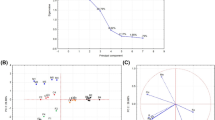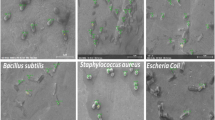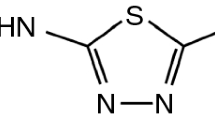Abstract
A useful microcalorimetric technique based on the bacterial heat production was applied to evaluate the antibacterial effects of Benzoinum and Styrax on the growth of Staphylococcus aureus (S. aureus). The thermogenic power-time curves of S. aureus growth in the presence of the two drugs were determined by a thermal activity monitor (TAM) air isothermal microcalorimeter, ampoule mode, at 310 K. Some quantitative metabolic parameters, such as growth rate constant k, the heat-flow power P, the appearance time for the heat power t, and the heat production Q were obtained from these curves. By analyzing these curves and some quantitative parameters using principal component analysis (PCA), the antibacterial effects of Benzoinum and Styrax on S. aureus growth were accurately evaluated from the change of the two main parameters, the heat-flow power for the second peaks P 2nd and total heat production Q t: the antibacterial effects of the two drugs at concentrations of 0–125 mg mL−1 were both enhanced with increasing the concentration, and Benzoinum with IC50 of 132.2 mg mL−1 had stronger antibacterial effect than Styrax with IC50 of 179.8 mg mL−1. This study provides some useful references for the application of Benzoinum and Styra as potential antibacterial agents. Microcalorimetry is a powerful analytical tool for the characterization of the microbial growth progress and the evaluation of the drugs’ efficiency.




Similar content being viewed by others
References
China Pharmacopoeia Committee. Pharmacopoeia of the People’s Republic of China, 1st Div. 2005 ed. Chinese Chemical Industry Press, Beijing; 2005. p. 101 and 113–114.
Coppen JJW. Benzoin: production, uses and international trade. Perfum Flavor. 1999;24:11–22.
Filippi JJ, Castel C, Fernandez X, Rouillard M, Gaysinski M, Lavoine-Hanneguelle S. An unusual acenaphthylene-type sesquiterpene hydrocarbon from Siam and Sumatra benzoin gum. Phytochem Lett. 2009;2:216–9.
Fritsch PW. Phylogeny of Styrax based on morphological characters with implications for biogeography and infrageneric classification. Syst Bot. 1999;24:356–78.
Moon HI, Lee J, Chung JH. The effect of erythrodiol-3-acetate on the expressions of matrix metalloproteinase-1 and type-1 procollagen caused by ultraviolet irradiated cultured primary old aged human skin fibroblasts. Phytomedicine. 2006;13:707–11.
Min BS, Oh SR, Ahn KS, Kim JH, Lee J, Kim DY, Kim EH, Lee HK. Anti-complement activity of norlignans and terpenes from the stem bark of Styrax japonica. Planta Med. 2004;70:1210–5.
Min BS, Na MK, Oh SR, Ahn KS, Jeong GS, Li G, Lee SK, Joung H, Lee HK. New furofuran and butyrolactone lignans with antioxidant activity from the stem bark of Styrax japonica. J Nat Prod. 2004;67:1980–4.
Chowdhry BZ, Beezer AE, Greehow EJ. Calorimetry in the biological sciences. Talanta. 1983;30:209–12.
Rodríguez de Rivera M, Socorro F. Flow microcalorimetry and thermokinetics of liquid mixtures. J Therm Anal Calorim. 2007;87:591–4.
Liu W, Chaspoul F, Lefranc DB, Decome L, Gallice P. Microcalorimetry as a tool for Cr(VI) toxicity evaluation of human dermal fibroblasts. J Therm Anal Calorim. 2007;89:21–4.
Khvedelidze M, Mdzinarashvili T, Partskhaladze T, Nafee N, Schaefer UF, Lehr CM, Schneider M. Calorimetric and spectrophotometric investigation of PLGA nanoparticles and their complex with DNA. J Therm Anal Calorim. 2010;99:337–48.
Zhao YL, Yan D, Wang JB, Zhang P, Xiao XH. Anti-fungal effect of berberine on Candida albicans by microcalorimetry with correspondence analysis. J Therm Anal Calorim. doi 10.1007/s10973-009-0565-7.
Boling EA, Blanchard GC, Russcal WJ. Microcalorimetric study the growth of bacteria. Nature. 1973;241:472–3.
Kong WJ, Zhao YL, Shan LM, Xiao XH, Guo WY. Thermochemical studies on the quantity-antibacterial effect relationship of four organic acids from Radix Isatidis on Escherichia coli growth. Biol Pharm Bull. 2008;31:1301–5.
Batovska D, Parushev ST, Slavova A, Bankova V, Tsvetkova I, Ninova M. Study on the substituents’ effects of a series of synthetic chalcones against the yeast Candida albicans. Eur J Med Chem. 2007;42:87–92.
Liu Y, Tan AM, Xie CL, Wang CX. Thermokinetic study of bacterial arithmetic series growth. Acta Phys Chim Sin. 1996;12:451–5.
Leng P, Guo XL, Yang Y, Lou HX. Primary study on anti-fungal activities and reversal of fluconazole resistance of Plagiochin E. Chin Pharm J. 2007;42:349–52.
Kong WJ, Wang JB, Jin C, Zhao YL, Dai CM, Xiao XH, Li ZL. Effect of emodin on Candida albicans growth investigated by microcalorimetry combined with chemometric analysis. Appl Microbiol Biotechnol. 2009;83:1183–90.
Kong WJ, Zhao YL, Xiao XH, Li ZL, Ren YS. Action of palmatine on Tetrahymena thermophila BF5 growth investigated by microcalorimetry. J Hazard Mater. 2009;168:609–13.
Wadsö I. Characterization of microbial activity in soil by use of isothermal microcalorimetry. J Therm Anal Calorim. 2009;95:843–50.
Kong WJ, Zhao YL, Shan LM, Xiao XH, Guo WY. Microcalorimetric studies of the action of four organic acids in Radix isatidis on the growth of microorganisms. Chin J Biotechnol. 2008;24:646–50.
Massart DL, Vandeginste BGM, Deming SN, Michotte Y, Kaufman L. Chemometrics: a textbook. New York, NY: Elsevier; 1988.
Kong WJ, Zhao YL, Xiao XH, Li ZL, Jin C, Li HB. Investigation of the anti-fungal activity of coptisine on Candida albicans growth by microcalorimetry combined with principal component analysis. J Appl Microbiol. 2009;107:1072–80.
Ivosev G, Burton L, Bonner R. Dimensionality reduction and visualization in principal component analysis. Anal Chem. 2008;80:4933–44.
Alonso-Salces RM, Héberger K, Holland MV, Moreno-Rojas JM, Mariani C, Bellan G, Reniero F, Guillou C. Multivariate analysis of NMR fingerprint of the unsaponifiable fraction of virgin olive oils for authentication purposes. Food Chem. 2010;118:956–65.
Kong WJ, Jin C, Xiao XH, Zhao YL, Li ZL, Zhang P, Liu W, Li XF. Comparative study of effects of two bile acid derivatives on Staphylococcus aureus by multiple analytical methods. J Hazard Mater. 2010;179:742–7.
Acknowledgements
We are grateful to the support of National Basic Research Program of China (973 project) (2007CB512606). We thank the reviewers for their critical comments on the manuscript.
Author information
Authors and Affiliations
Corresponding author
Rights and permissions
About this article
Cite this article
Wang, J., Cheng, D., Zeng, N. et al. Application of microcalorimetry and principal component analysis. J Therm Anal Calorim 102, 137–142 (2010). https://doi.org/10.1007/s10973-010-0929-z
Received:
Accepted:
Published:
Issue Date:
DOI: https://doi.org/10.1007/s10973-010-0929-z




